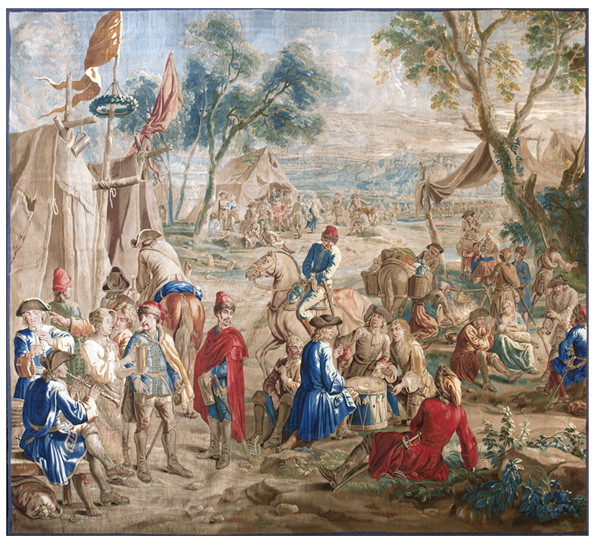
Camp Life
A fine Brussels tapestry, from the Arts of War III series, 1734-41, designed by Philippe De Hondt (1683–1741), woven in the workshop of Urbain Leyniers, c1735.
Woven with fine wool and silk threads.
Height : 9ft 2in (278cm) Width : 9ft 11in (303cm)
Following on from his father, Lambert De Hondt who designed the first series of the Arts of War for the Le Clerc and Van der Borcht workshops of Brussels in 1695, which received many commissions from European rulers, Philippe De Hondt designedthe Victories of the Duke of Marlborough (Blenheim Palace, Oxford, the palace was originally intended to be a reward to John Churchill, 1st Duke of Marlborough, from a grateful nation for the duke's military triumphs against the French and Bavarians during the War of the Spanish Succession, culminating in the 1704 Battle of Blenheim) in 1712-15 and the Art of War ÍÍ of 1715-20, both woven in the workshop of Judocus de Vos of Brussels.
Philippe de Hondt was registered as a master in the Brussels painters' guild in 1708 and with the popularity of these military sets, inspired Urban Leyniers to commission the Art of War III series from Philippe De Hondt in 1735 when, after the death of the principal designer Jan Van Orley, De Hondt was granted priveliges and he then became the most important Brussels tapestry designer, this set is mentioned in the Leyniers inventory as cat no 13.The large figurative tapestry series of the grand gout style, as those designed by Jan Van Orley was becoming unfashionable and was replaced by the gout moderne, now known as the Regency or Rococo style, depicting modern life with peasant scenes and military compositions with figures of small personage.
There was a set of six tapestries, bought in 1750 and signed by Leyniers, that survived in the Muschelsaal of the Rathaus of Cologne of which Camp Life is similar to the present tapestry. A further similar example was illustrated by Joseph Duverger in Aantekeningen betreffende de tapijten in Artes Textiles 7 (1971). These two examples of Camp Life are the only ones recorded, both with picture frame borders of different designs.
There are design details which are interesting to note, the laurel leaf wreath on the flag pole signifies victory, the three figures with moustaches and darker facial tones, one on horseback, have uniforms which differ from the rest and they are all carrying the pallasch type of sword which was popular in Poland.
The present rare tapestry, made of fine wool and silk threads, is exceptionally fresh in retaining original colour and of perfect condition. The size is original, though the border (also picture frame design) has been removed.
Literature
Koenraad Brosens, A Contextual Study of Brussels tapestry, dye works and tapestry workshop of Urban Leyniers. 2004, Cat no 9/16a.
Alain Wace, The Marlborough Tapestries at Blenheim Palace, Phaidon, 1968, p111, pl 74.